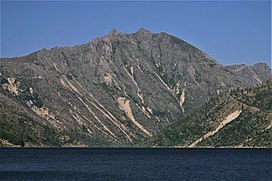| Minnie Peak | |
|---|---|
 West aspect, from Coldwater Lake West aspect, from Coldwater Lake | |
| Highest point | |
| Elevation | 5,610 ft (1,710 m) |
| Prominence | 890 ft (270 m) |
| Parent peak | Mount Venus (5,820 ft) |
| Isolation | 1.68 mi (2.70 km) |
| Coordinates | 46°19′40″N 122°11′23″W / 46.327769°N 122.189707°W / 46.327769; -122.189707 |
| Geography | |
  | |
| Country | United States |
| State | Washington |
| County | Skamania |
| Protected area | Mount St. Helens National Volcanic Monument |
| Parent range | Cascade Range |
| Topo map | USGS Spirit Lake West |
| Geology | |
| Rock type | granodiorite |
| Volcanic arc | Cascade Volcanic Arc |
| Climbing | |
| Easiest route | scrambling |
Minnie Peak is a 5,610-ft (1,710 m) mountain summit located in Mount St. Helens National Volcanic Monument, in Gifford Pinchot National Forest, in Skamania County of southwest Washington state. It is situated in the Cascade Range, one mile northeast of Coldwater Lake, and 2.7 mi (4.3 km) west of Mount Whittier. Its nearest higher neighbor is Mount Venus, 1.67 mi (2.69 km) to the northeast, Coldwater Peak rises 2 mi (3.2 km) to the south, and Mount St. Helens is 9 mi (14 km) to the south. Although modest in elevation, relief is significant as the summit rises 3,000 feet above the Coldwater Creek valley in less than one mile. Precipitation runoff from Minnie Peak drains south into Coldwater Creek, or north into Miners Creek, both of which are part of the North Fork Toutle River drainage basin. This peak's name is derived from the Minnie mining claim nearby along Miners Creek. The primary minerals extracted there were silver and copper.
Geology
The history of the formation of the Cascade Mountains dates back millions of years ago to the late Eocene Epoch. Geological events occurring many years ago created the diverse topography and drastic elevation changes over the Cascade Range leading to various climate differences. During the Pleistocene period dating back over two million years ago, glaciation advancing and retreating repeatedly scoured and shaped the landscape. With the North American Plate overriding the Pacific Plate, episodes of volcanic igneous activity occurred. The lateral blast from the 1980 eruption of Mount St. Helens was pointed toward Minnie Peak and stripped the vegetation from its slopes. Due to Mount St. Helens' proximity to Minnie Peak, volcanic ash is common in the area. Minnie Peak and nearby Mount Whittier are composed of resistant granodiorite of the Spirit Lake pluton, which is a complex of once-molten rock that intruded the surrounding rocks approximately 20 million years ago.
Climate
Minnie Peak is located in the marine west coast climate zone of western North America. Most weather fronts originate in the Pacific Ocean, and travel northeast toward the Cascade Mountains. As fronts approach, they are forced upward by the peaks of the Cascade Range (Orographic lift), causing them to drop their moisture in the form of rain or snowfall onto the Cascades. As a result, the west side of the Cascades experiences high precipitation, especially during the winter months in the form of snowfall. During winter months, weather is usually cloudy, but due to high pressure systems over the Pacific Ocean that intensify during summer months, there is often little or no cloud cover during the summer. The months July through September offer the most favorable weather for viewing or climbing this peak.
See also
Gallery
-
 Minnie Peak reflected in Coldwater Lake
Minnie Peak reflected in Coldwater Lake
-
 Minnie Peak and Coldwater Lake
Minnie Peak and Coldwater Lake
-
 Summit detail
Summit detail
-
 Minnie Peak and Coldwater Lake
Minnie Peak and Coldwater Lake
-

-

References
- ^ "Minnie Peak, Washington". Peakbagger.com.
- "Minnie Peak - 5,610' WA". listsofjohn.com. Retrieved August 19, 2020.
- "Minnie Peak". Geographic Names Information System. United States Geological Survey, United States Department of the Interior. Retrieved August 19, 2020.
- Minnie Alice Prospect, Westernmininghistory.com
- ^ Kruckeberg, Arthur (1991). The Natural History of Puget Sound Country. University of Washington Press.
- Patrick T. Pringle, ROADSIDE GEOLOGY OF MOUNT ST. HELENS NATIONAL VOLCANIC MONUMENT AND VICINITY, 1993, pg. 51.
- Beckey, Fred W. Cascade Alpine Guide, Climbing and High Routes. Seattle, WA: Mountaineers Books, 2008.
External links
- Weather forecast: Minnie Peak